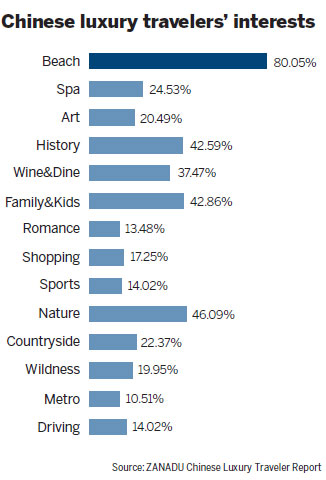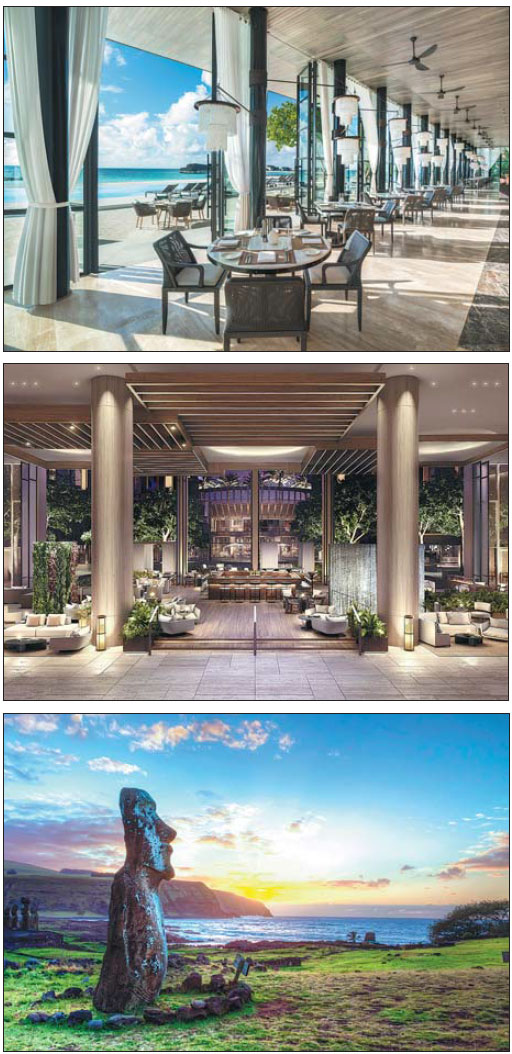Hey, big spender
With Chinese travelers proving they have some of the deepest pockets in the world, luxury hotels have been pulling out all the stops to cater to their needs and preferences
Naoya Sato's recent marketing pitch about the soon-to-be-opened Hotel de Crillon in Paris summed up just how serious luxury hotels are about attracting Chinese travelers.
The senior sales manager of the iconic French hotel was speaking at the 11th International Luxury Travel Market Asia in Shanghai in June. Hotel de Crillon has been undergoing renovations for the past four years and is scheduled to reopen in July.
Apart from the many bells and whistles such as the rich history of the building and the two suites that were designed by fashion mogul Karl Lagerfeld, the hotel will also feature not one, but five Mandarin-speaking Chinese butlers.
|
From top: The Alba Restaurant of the St. Regis Maldives. The lobby of Fairmont Central Plaza in Los Angeles. Easter Island in Chile is one of the most popular destinations for high-end consumers, according to a report by luxury travel agency HHtravel. Photos Provided to China Daily |
Rosewood's attempt to attract Chinese guests is hardly surprising, seeing how these individuals are the biggest spenders in the world.
Due to China's rapid economic growth in the past and the ever-rising disposable incomes of the burgeoning middle class, tourism expenditures by Chinese have experienced double-digit growth every year since 2004.
The latest figures from the United Nations World Tourism Organization showed that Chinese outbound tourists spent a whopping $261 billion in 2016, twice the amount spent by travelers from the US. Statistics from the China National Tourism Administration showed that the number of outbound Chinese travelers also rose 4.3 percent to 122 million in 2016, cementing China's position as the top source market in the world since 2012.
Held at the Shanghai Exhibition Center from June 5 to 8, ILTM Asia attracted upwards of 600 luxury travel service suppliers from around the world and another 600 buyers from 26 Asian markets, both increasing roughly 20 percent year-on-year.
A joint report released by ILTM Asia and China wealth watcher Rupert Hoogewerf pinned down the spending habits of the country's high-net-worth crowd by interviewing 334 Chinese who spent an average of 380,000 yuan ($55,650) on their travels in 2016.
More than 30 percent of the interviewees said they spent over 5,000 yuan per night on hotel rooms, an amount Hoogewerf has said is unprecedented. On average, however, these individuals spent about 3,800 yuan per night on accommodation. Most of them also favored niche boutique hotels over renowned chains.
In line with their preferences for bespoke luxury products, personalized services instead of brand recognition and discounts were cited as the top priority for these travelers, added Hoogewerf.
Amrita Banda, managing director of Agility Research & Strategy, the partner consultancy of ILTM Asia, pointed out that the desire to travel among the Chinese has not been dampened despite the current security situation in the world, especially in Europe where a spate of terror attacks have taken place in France and the United Kingdom this year.
She added that the question she is most frequently asked these days is: "What does a Chinese luxury traveler like?"
Oddly enough, as much as Chinese travelers love spending on premium goods, they also cannot do without the humble snack of cup noodles.
As such, the InterContinental Hotel Group has ensured that their Chinese guests are provided with eletric kettles so that they can prepare their noodles and make tea. Bedroom slippers have also been identified as a must-have for these guests. The hotel has even gone to the extent of partnering with advertising agency Ogilvy to create a video campaign to communicate these offerings.
"We used to have more than a third of the Chinese tourists complaining about the lack of an electric kettle in the room," said Emily Chang, chief commercial officer of the group.

Meanwhile, Shangri-La Hotels and Resorts will on Aug 1 launch a new initiative that is specially tailored for their Chinese guests across its properties at 35 destinations. Dubbed "xiangju", which means "reunion" in Chinese, the program will include the use of WeChat, China's most popular social media tool, for payment and communication between guests and hotel staff, information guides in Mandarin as well as Chinese tea and cuisines.
Over at Marriott, the world's largest hotel group, efforts to lure Chinese guests include introducing well-loved food and snacks to their breakfast selection. Since late 2016, Marriott has been serving soy milk, fried dough and steamed buns for breakfast across its hotels in the most popular destinations for Chinese travelers like Paris, London and Bangkok.
The Hoogewerf report revealed that 22 percent of the Chinese travelers polled said that food is a key element when choosing hotels.
Fifty-six percent of the travelers said they were eager to try a country's local cuisine at the hotels in which they stay, while 30 percent indicated a preference for Cantonese and Japanese cuisines. Italian food fared the worst in the survey, ranking the lowest among the 10 choices, after Southeast Asian cuisine and a buffet spread.
To capitalize on this love for food, Mandarin Oriental has partnered with high-end dining group Hakkasan to open its first Chinese fine dining restaurant outside Asia at its Marrakech property in Morocco.
Called Ling Ling, a colloquial Chinese name for girls, the restaurant not only stands out as the most premium fine dining destination for China's Cantonese cuisine, but also as one of the few Chinese restaurants opened by a luxury hotel group outside China.
xujunqian@chinadaily.com.cn
(China Daily 06/24/2017 page10)















